Significant Supreme Court Decisions
Standard 5.6: Significant Supreme Court Decisions
Research, analyze and report orally or in writing on one area [5.6a, 5.6b, or 5.6c below] in which Supreme Court Decisions have made significant changes over time in citizens’ lives. (Massachusetts Curriculum Framework for History and Social Studies) [8.T5.6]
Standard 5.6a: Supreme Court Decisions: First Amendment Rights
Interpretations of the freedoms of Religion, Assembly, Press, Petition, and Speech under the First Amendment. (Massachusetts Curriculum Framework for History and Social Studies) [8.T5.6.a.]

FOCUS QUESTION: How Do Landmark Supreme Court Cases Impact Our Lives?
A landmark case is a case that has an “lasting effect on the application of a certain law, often concerning your individual rights and liberties” (Judicial Learning Center, 2015, para. 2), including:
- United States v. Wong Kim Ark (1898) established that the 14th Amendment granted citizenship to anyone born in the U.S.
- Brown v. Board of Education of Topeka (1954) declared that the doctrine of separate but equal is inherently unequal. Explore the case in Brown Revisited, an AI-generated reconstruction of the people and their actions in their own words.
- Gideon v. Wainwright (1963) gave anyone charged with a crime the right to an attorney whether they could afford one or not.
- Miranda v. Arizona (1966) said that police officers must advise prisoners of their rights before being questioned.
- Tinker V. Des Moines (1969) declared students have free speech rights in schools if they are not disrupting the educational process.
- Roe v. Wade (1973) established a woman’s constitutional right to an abortion.
- Lau v. Nichols (1974) stated that schools must provide English language instruction for students who are learning English as a new language.
- Obergefell v. Hodges (2015) legalized same-sex marriage in all 50 states.
- Held v. Montana (2023) marked the nation's first constitutional and youth-led climate lawsuit to go to trial.
However, the Court's landmark decisions have also, and more often than not, been in Lawrence H. Tribe (2023, p. 51) words, "shockingly reactionary and even repressive," including
- Dred Scott v. Sanford (1857) "holding that Black Americans could never become citizens";
- Giles v. Harris (1903) that held the Supreme Court could not challenge states' that completely denied voting rights to Black citizens;
- Lochner v. New York (1905) that took away state government's powers to regulate sweatshop working conditions;
- Hammer v. Dagenhart (1918) "depriving Congress of the authority to forbid the interstate sale of the products of child labor";
- Buck v. Bell (1927) that allowed sterilization of women deemed to have substandard intelligence;
- Korematsu v. United States (1944) that upheld Japanese internment during World War II; and most recently,
- Dobbs v. Jackson Women's Health Organization (2022) that reversed the Roe reproductive rights decision and declared that abortion is no longer protected under the U.S. Constitution.
Viewing the history of Supreme Court decisions from a people's history perspective, constitutional scholar Peter Irons (1999, pp. xiii) noted that many landmark cases have been brought by "blacks, women, and religious and political dissenters"; they were appeals by "powerless 'outsiders' to the powerful 'insiders' who have shaped the Constitution's meaning over the past two centuries."
Each landmark case stemmed from a "case or controversy that began with claims to constitutional protection by ordinary Americans" (Dred Scott, Homer Plessy, Wong Kim Ark, Fred Korematsu, Oliver Brown, Clarence Earl Gideon, Norma McCorvey, and Kenney Kimmon Lau) and each case "brought into the courtroom an unresolved political conflict: slavery, racial segregation, patriotic conformity, military power, abortion, or gay rights" (Irons, 1999, pp. xiv). Largely but not exclusively, the Court's decision in landmark cases reflected the interests of the President and political party who appointed the justices to the bench.
What is the future for individual rights and civil liberties in our society? The modules for this topic consider how the Supreme Court has interpreted the rights of individuals in six areas of rights in conflict and what those interpretations mean for current and future policies: the First Amendment; due process; the flag and the Pledge of Allegiance; school prayer; national security; and gun control.
Read more in the book Fight of the Century: Writers Reflect on 100 Years of Landmark ACLU Cases, edited by Michael Chabon and Ayelet Waldman (Simon & Schuster, 2020).
Learn more from the graphic book, Free Speech Handbook: A Practical Framework for Understanding Our Free Speech Protections by Ian Rosenberg (2021), part of the World Citizen Comic Series.
Modules for this Standard Include:
- INVESTIGATE: Landmark First Amendment Rights Cases
- MEDIA LITERACY CONNECTIONS: Television Cameras and Other Media in Courtrooms
- UNCOVER: Tinker v. Des Moines and the Boundaries of Student Speech in Schools
- INVESTIGATE: Due Process and Equal Rights: Mendez v. Westminster (1947)
- INVESTIGATE: The U.S. Flag and the Pledge of Allegiance
- INVESTIGATE: School Prayer
- INVESTIGATE: National Security
- INVESTIGATE: Gun Control
1. INVESTIGATE: Landmark First Amendment Rights Cases
The First Amendment of the Constitution states; "Congress shall make no law respecting an establishment of religion, or prohibiting the free exercise thereof; or abridging the freedom of speech, or of the press; or the right of the people peaceably to assemble, and to petition the Government for a redress of grievances."
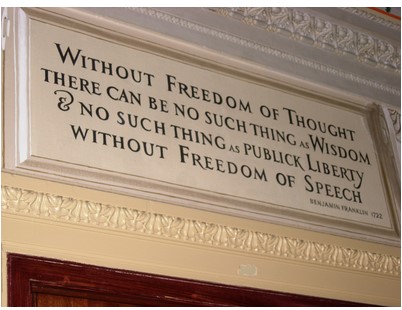
Take this News Lit Quiz: So, what’s the First Amendment? to test out your understanding of the First Amendment and/or explore The First Amendment interactive lesson by Checkology (News Literacy Project).
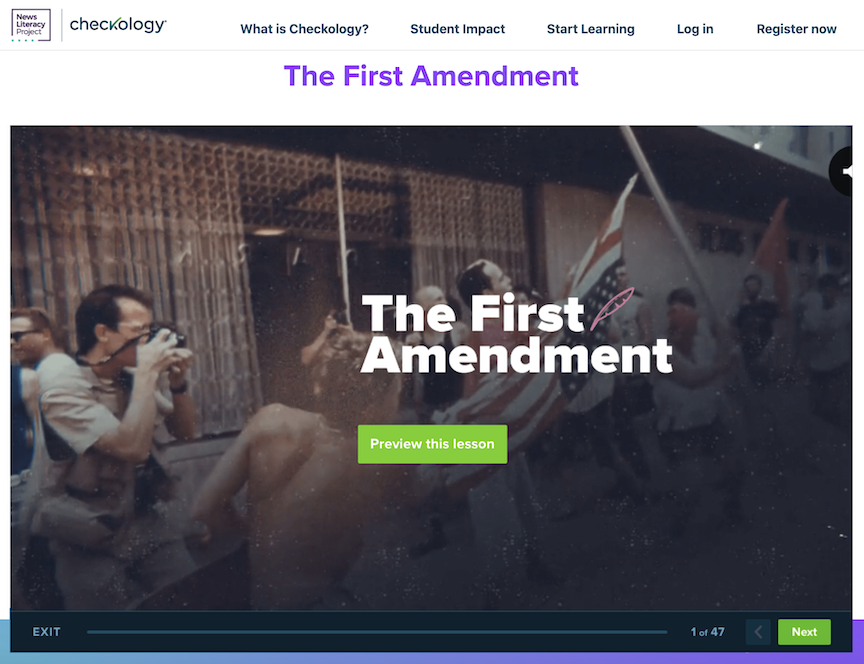
In its interpretations of the First Amendment, the Supreme Court has produced far-reaching legal decisions, including:
- Schenck v. U.S. (1919)
- Criticism of the Military Draft is not protected by the First Amendment when that speech poses a clear and present danger to the government.
- Abrams v. U.S. (1919)
- In this case the defendants were convicted on the basis of two leaflets they printed and threw from windows of a building in New York City. One leaflet, signed "revolutionists," denounced the sending of American troops to Russia. The second leaflet, written in Yiddish, denounced the war and U.S. efforts to impede the Russian Revolution and advocated the cessation of the production of weapons to be used against Soviet Russia.
- In this case, Justice Oliver Wendell Holmes delivered his famous defense of free speech in The Most Powerful Dissent in American History.
- Whitney v. California (1927)
- States can prohibit speech that may incite criminal activity.
- Stromberg v. California (1931)
- States cannot infringe on First Amendment right to speech and expression.
- Near v. Minnesota (1931)
- States cannot prohibit malicious and defamatory content from newspapers.
- Brandenburg v. Ohio (1969)
- States cannot broadly prohibit speech and expression.
- Texas v. Johnson (1989)
- Flag burning is a form of protected speech and expression.
- Tinker v. Des Monies (1969)
- Administrators cannot ban political protest in schools.
- For more, see Landmark Ruling on Behalf of Student Expression from the American Civil Liberties Union.
- Reno v. ACLU (1996)
- Ruled against vague content bans on free speech.
- Hazelwood School District v. Kuhlmeier (1988)
- High school student newspapers are subject to a lower level of First Amendment Rights.
- Olmstead v. LC and EW (1999)
- Social services for individuals with disabilities must be provided in the most integrated setting appropriate to the needs of an individual.
- Lawrence v. Texas (2003)
- Declared unconstitutional a Texas law prohibiting sexual acts between same sex couples, expanding privacy rights of all Americans.
- Hamdan v. Rumsfeld (2006)
- Imposed legal constraints of the Bush administration's program for trying alleged terrorists by military commissions.
- Safford Unified School District v. Redding (2009)
- Ruled school officials violated the constitutional rights of a 13-year-old Arizona girl when they conducted a strip search based on a classmate's uncorroborated accusation.
- Obergefell v. Hodges (2015)
- Supreme Court declares same-sex marriage is legal in all 50 states.
Learn more about significant Supreme Court decisions at the First Amendment Encyclopedia from Middle Tennessee State University and Supreme Court Decisions on First Amendment Individual Rights.
Media Literacy Connections: Television Cameras and Other Media in Courtrooms
During the COVID-19 Pandemic (April 2020), for the first time in history, the Supreme Court announced it would make publicly available an audio feed of oral arguments between lawyers and the justices, which were being conducted by telephone conference calls. Before that, no audio/video recording, photography, or television/live streaming had been allowed in the Supreme Court's courtroom.
Federal Rule of Criminal Procedure 53, adopted in 1946, prohibits photographing or broadcasting in a courtroom during a judicial proceeding.
Since 1996, a small number of federal courts of appeals and district courts have begun allowing photography and television coverage of oral arguments (SCOTUS blog, April 27, 2020). There have also been pilot projects that allow judges to permit broadcasting, recording, photographing of certain parts of proceedings or authorize live streaming of remote public audio except when witnesses are testifying (History of Cameras, Broadcasting and Remote Public Access in Courts).
Many lawmakers, lawyers, and members of the public believe cameras, television, and/or live streaming should be allowed in the Supreme Court and other courtrooms, while other people are unwilling to depart from historical precedent. The first bill to allow cameras in federal courts was introduced in 1937. C-Span (Cable-Satellite Public Affairs Network) began broadcasting the House of Representatives in 1979 and the Senate in 1986.
Congress is considering the Cameras in the Courtroom Act, introduced in 2019, which would permit television coverage of all open sessions of the Supreme Court, unless a majority of the Justices voted otherwise in order to protect the rights of those involved in a case.
In these activities, you will analyze the question of whether cameras (either still photographs or live streaming) should be allowed in judicial courtrooms, and if so, how Supreme Court proceedings should be televised or livestreamed. In so doing, you will consider how the nation's legal system can best balance every individual's right to a fair trial with the public's right to know what is happening in courts.
- Activity 1: Analyze the Implications of Cameras in Courtrooms
- Activity 2: Design a Format for Future Supreme Court TV Coverage

1.1. UNCOVER: Tinker v. Des Moines (1969) and the Boundaries of Student Speech in Schools
In December 1965, during a period of nationwide protests against the American War in Vietnam, 13-year-old Mary Beth Tinker and a group of her junior high school classmates wore black armbands to school to express their opposition to the war.

School administrators told the students to remove the armbands and when the students refused, suspended them. When they returned to school after the holiday break, the students gave up the armbands, wore black for the rest of the year in protest, and took the school all the way to the Supreme Court.
In 1969, by a 7 to 2 vote, the Supreme Court agreed with the students, declaring in a memorable phrase that students do not “shed their constitutional rights to freedom of speech or expression at the schoolhouse gate.”
The Court said school officials could not block wearing armbands as a form of constitutionally protected free speech, unless the actions of students had disrupted the educational process—which they had not.
Explore Tinker v. Des Moines (1969) - Landmark Supreme Court Ruling on Behalf of Student Expression.
Watch the video Constitution Hall Pass: Tinker v. Des Moines from the National Constitution Center.
Student Speech and Social Media
The Tinker case invites a wider exploration of the boundaries of student speech in school in an era of social media. Courts have established that schools in general have a right to regulate student speech if that speech disrupts normal everyday school operations. But, what are those limits when student speech is easily shared on social media platforms? Here are two important recent cases that seek to define those limits.
Hawk v. Easton Area School District (2013)
In the Hawk v. Easton Area School District (2013) case, two students wore “I <3 Boobies” (I Heart Boobies) bracelets to school to support a local breast cancer awareness campaign. School administrators banned the bracelets as a violation of the school dress code policy that prohibited lewd or vulgar language on clothing. Citing their right to free speech, the students wore the bracelets anyways, were suspended, and their mothers took the school system to court. The U.S. Court of Appeals overturned the ban, stating that the bracelets were not plainly lewd and because they commented on a social issue, they may be worn in school.
Mahanoy Area School District v. B.L. (2018)
Mahanoy Area School District v. B. L, a case decided by the U.S. Supreme Court in June 2018, centers on a high school student who in 2017 posted profanity-laden comments on Snapchat after learning she did not make her school's varsity cheerleading squad. She put a "f-bomb" before the words "school," "softball," "cheer," and "everything." The school kicked her off the cheerleading team even though her comments were made on social media and off the school's campus.
A U.S. Court of Appeals ruled that although her post was "crude, rude, and juvenile," it was protected by the First Amendment because it did not substantially disrupt school activities or operations. School administrators disagreed, arguing that they can prohibit student speech that is vulgar or lewd, especially since members of the school community can easily access the post on social media.
The Supreme Court, by an 8 to 1 majority, agreed that the student cannot be disciplined by the school district for off-campus speech, marking it the first time in 50 years that the justices had ruled in favor of a student in a free speech case. Writing for the majority, Justice Stephen G. Breyer said "America's public schools are the nurseries of democracy" and our system of government works only when we protect the "marketplace of ideas."
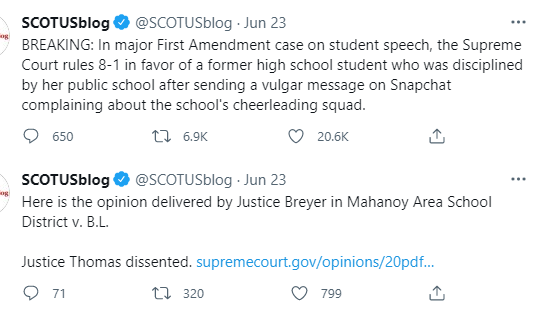
Breyer acknowledged that schools have "special characteristics that give additional license to regulate student speech" such as in the cases of severe bullying or harassment, threats against teachers, violations of rules about writing and school assignments, and breaches of school security devices. But, when students express vulgar or objectionable ideas off-campus and outside of school hours, a school cannot regulate it or seek to prevent it. Courts, Breyer said, "must be more skeptical of a school’s efforts to regulate off-campus speech, for doing so may mean the student cannot engage in that kind of speech at all."
Learn more at:
- In a Win for Student Speech, Supreme Court Rules in Favor of the 'Snapchat Cheerleader' (EdSurge, June 23, 2021)
- What Can I Say in School? An Examination of Students' Freedom of Speech, National Constitution Center.
- NCTE Responds to U.S. Supreme Court Mahanoy v. B.L. Ruling and text of NCTE's Amicus Brief
Suggested Learning Activities
- Design a Student Bill of Rights
- Review the following resources:
- Student Bill of Rights, National Youth Rights Association
- You Can't Say That in School?! Newseum
- 11 Rights All Students (Should) Have
- Then create your own student Bill of Rights.
- Review the following resources:
- Create a Poster
- Design a poster (drawing or digital) that summarizes Student Rights in one or more of the following areas:
- Speech
- Privacy
- Religion
- Dress Codes
- Banned Books
- Drug Testing
- Design a poster (drawing or digital) that summarizes Student Rights in one or more of the following areas:
- Create a Public Service Announcement
- Design a public service announcement to advocate for increased student rights in school based on the First Amendment.
Standard 5.6b: Supreme Court Decisions: Due Process and Equal Protection
Interpretations of the due process clause and the equal protection clause of the 14th Amendment. (Massachusetts Curriculum Framework for History and Social Studies) [8.T5.6.b.]
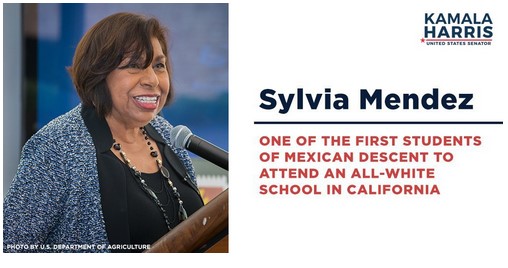
2. INVESTIGATE: Due Process and Equal Protection: Mendez v. Westminster (1947)
Just after the end of World War II, Sylvia Mendez was eight years-old and a student at a racially segregated elementary school in Westminster, California. She wanted to attend a nearby school, but it was reserved for white-only students. Her parents (along with four other Mexican-American families) sued the school district on behalf of the community’s 5,000 Latino and Latina students. In 1946, the plaintiffs won their case in federal court, making it the first time in U.S. history that a school district was told it had to desegregate. Watch here as Sylvia Mendez recalls the time and the lawsuit.
The Mendez case had enormous implications for civil rights in the country. It preceded the Brown v. Board of Education school desegregation decision by eight years. Future Supreme Court Justice Thurgood Marshall represented both Sylvia Mendez and later Linda Brown in the Brown v. Board of Education case. He used some of the same arguments from the Mendez case to win the Brown decision.
In the Mendez v. Westminster case, the judge wrote these words challenging the “separate but equal” doctrine established in the Plessy v. Ferguson case in 1898:
The equal protection of the laws’ pertaining to the public school system in California is not provided by furnishing in separate schools the same technical facilities, textbooks and courses of instruction to children of Mexican ancestry that are available to the other public school children regardless of their ancestry. A paramount requisite in the American system of public education is social equality. It must be open to all children by unified school association regardless of lineage.
A national hero, Sylvia Mendez received a 2010 Presidential Medal of Freedom and in 2018 was awarded the National Hispanic Hero Award. She continues to work for equality and justice for Latinos and all people of color.
The Maestas Desegregation Case (1914)
A 1914 case, Francisco Maestas et al. v. George H. Shone, et al., is a little-known forerunner to Sylvia Mendez and her family's fight to end educational segregation of Mexican American children.
The case involved a railroad worker Francisco Maestas who was unable to enroll his son in the Alamosa, Colorado public school nearest their home. School officials demanded the boy attend a "Mexican school" with the district's other children of Mexican descent because it was assumed the children needed to learn English - even though most of the children at the school spoke English. The district court judge ruled in favor of the Maestas' family, stating that all English speaking children should be allowed to attend the school closest to their homes.
Efforts are underway to build a memorial to the case as a milestone in ending segregation of Mexican children based on language and race (The Most Important School Desegregation Case You've Never Heard Of, National Education Policy Newsletter, July 9, 2020).
Suggested Learning Activities
- Role-Play & Video Production
- Create a video re-enactment of the court case (see Mendez v. Westminster Re-Enactment).
Online Resources for Mendez v. Westminster
- Sylvia Mendez and the Mendez v Westminster Court Case, resourcesforhistoryteachers wiki
- Mendez v. Westminster Text & Lesson Plan, Teaching Tolerance
- Case Summary from Civics Resources for Texas Students & Teachers
- The Lasting Impact of Mendez v. Westminster in the Struggle for Desegregation
- Separate is Never Equal. Duncan Tonatiuh, 2014. This picture book about the Mendez v Westminster case lets youngsters access the story through illustrations and text. Here is the Educator's Guide to Separate Is Never Equal.
Standard 5.6c: Supreme Court Decisions: Rights in Conflict
Interpretations in cases where individual rights and perceived or community or national interest were in conflict. (Massachusetts Curriculum Framework for History and Social Studies) [8.T5.6.c.]
3. INVESTIGATE: Rights in Conflict: United States Flag and the Pledge of Allegiance
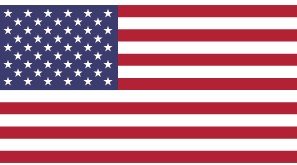
The 50 stars on the flag represent the 50 states of the United States of America. The blue square is officially known as the "union," as all of the states are bound in union. The 13 stripes represent the original 13 British colonies that declared independence from Great Britain.
Nicknames for the flag include "The Stars and Stripes," "Old Glory," and the "Star Spangled Banner.” Betsy Ross is popularly assumed to have created the first flag, but there is little historical evidence to indicate who actually made the first flag (Five myths about the American flag). In 1916, President Woodrow Wilson signed the law designating June 14 every year as Flag Day.
The picture book Long May She Wave: The True Story of Caroline Pickersgill and Her Star-Spangled Creation tells the story of two 13-year-olds (one white and one an African American indentured servant) who along with adults sewed the flag that inspired Francis Scott Key to write the Star-Spangled Banner song.
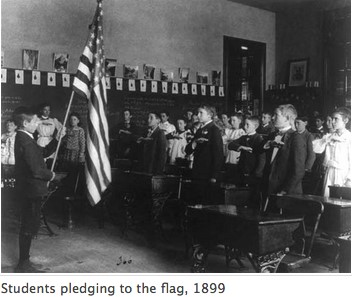
The display of the American flag and the playing of the National Anthem are highly contentious issues in contemporary American politics. As of 2022, 47 states require reciting the Pledge, although there are exemptions in some cases. The flag and the flag salute has also been at the center of a landmark Supreme Court case.
West Virginia State Board of Education v. Barnette (1943)
Although the Supreme Court established in West Virginia State Board of Education v. Barnette (1943) that students cannot be required to recite the pledge of allegiance in schools, all states except California, Hawaii, Iowa, Vermont and Wyoming have a rule that there be a regularly scheduled time to recite the pledge. In Alabama, for example, schools are required to “afford all public K–12 students an opportunity each school day to voluntarily recite the pledge of allegiance to the United States flag" (Pledge Law: Controlling Protest and Patriotism in Schools, Teaching Tolerance, May 29, 2019).
Interestingly, original Pledge was written in 1892 by Francis Bellamy, a Baptist minister and socialist and it did not contain the phrase "under God." Bellamy sought to revive patriotism by having school children recite a daily pledge to flag and country. The Pledge was formally adopted by Congress in 1942, but the phrase "under God" was added in 1954 at the height of the anti-communist Red Scare (learn more: The Gripping Sermon That Got ‘Under God’ Added to the Pledge of Allegiance on Flag Day, Washington Post).
Based on case law, as it stands today, students who refuse to stand for the Flag Salute or the National Anthem to make a political statement or act out of some discernible religious belief ARE exercising their rights of free expression.
The National Anthem
For many Americans, the national anthem is a time-honored, but increasingly less relevant tradition when played at sporting events and other occasions. Francis Scott Key wrote "The Star-Spangled Banner" in 1814 to commemorate the British shelling of Fort McHenry during the War of 1812. Today, as one sportswriter put it: "Only 8 million people lived in the United States when Key put ink to paper. What we are left with 206 years later is a poem written in 1814, fitted to a music sheet of the late 1700s, approved by Congress as our anthem in 1931, played routinely at sporting events now for some 350 million Americans to embrace as their hail to country. Clearly, not all of us are able to get our arms around it" (Dupont, 2020).
Flags as Symbols for Political Change
Often omitted in discussions about the national anthem are how flags have been used as symbols for political change throughout United States history:
- The Rainbow flag is the symbol of LGBTQIA rights (Who Made the Rainbow Flag?).
- The Juneteenth flag commemorates June 19, 1865, the day slaves in Texas learned they were free.
- The National Women's Suffrage Congressional Union flag was created by Alice Paul and Lucy Burns to support more aggressive protests for women's rights.
- The United Farm Workers Black Eagle Flag became a banner for Latino and Latina rights, heritage, and culture.
In 1969, in the Texas v. Johnson case, the Supreme Court estblished U.S. flag burning is a form of protected speech and expression.
Suggested Learning Activities
- State Your View: What does a flag, monument, or memorial mean as a national symbol?
- Explore the resourcesforhistoryteachers wiki page National Symbols, Flags, Phrases and Songs
- EDSITEment article Stars and Stripes Forever: Flag Facts for Flag Day
- What does the American flag mean to you?
- Design a Flag, Monument, or Memorial for a Cause or an Issue You Care About
- What would your flag mean to the groups it was created for?
- Analyze Song Lyrics about the Flag
- Go to the Patriotic Melodies Collection from the Library of Congress to access songs about America and the flag
- How is America and the flag represented in these songs? What emotions are the songs seeking to inspire in listeners? (Flag Day Learning Plan from the National Council of Teachers of English)
- Write Your Own Song to Inspire Change
3.1. ENGAGE: Is Symbolic Action an Effective Form of Political Protest?
Symbolic acts are forms of political protest. Kneeling during the national anthem, raising fists at an award ceremony, and wearing arm bands or shoes that have political messages are examples of individuals using symbolic actions to deliver their views to wider audiences. You can also explore the role of political protest in Topic 4.12 in this book.
In 2022, for example, at the World Cup, players from Germany covered their mouths during a team photo to protest an international soccer federation ban on wearing rainbow arm bands to support gay rights and to protest policies toward LGBTQIA people in the host country of Qatar.

Are such actions an effective form of political protest for athletes, everyday people, students in schools?
George Floyd Protests
In the weeks that followed the killing of George Floyd by Minneapolis, Minnesota police officers on May 25, 2020, hundreds of thousands of Americans engaged in marching and kneeling to speak out against police brutality and systematic racism.
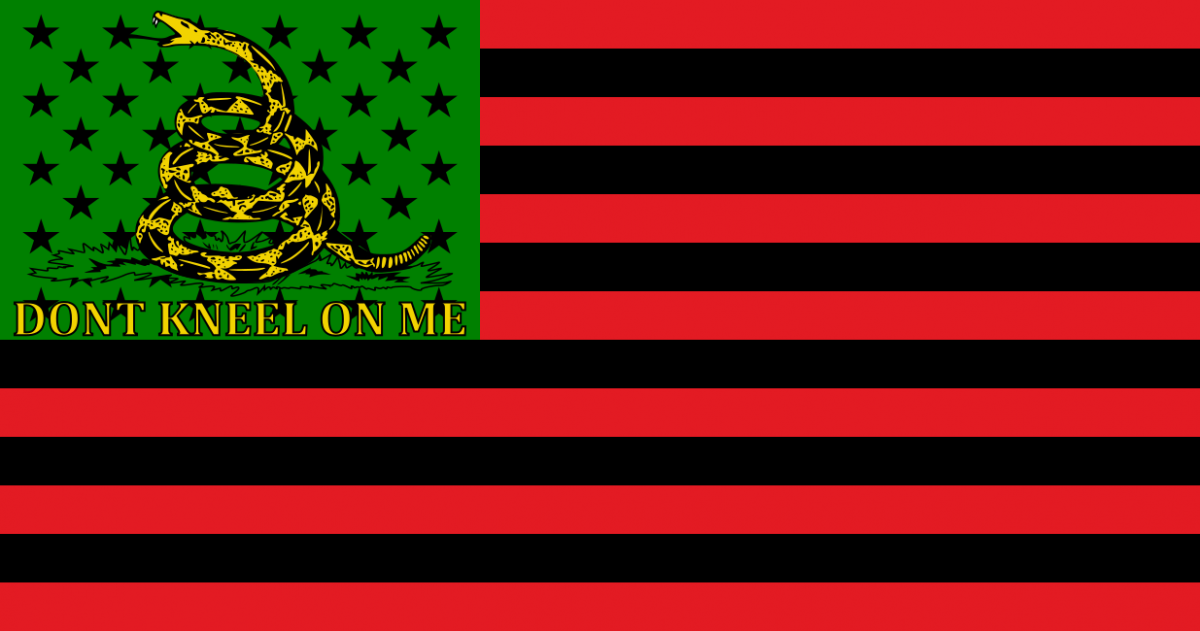
Throughout the rest of 2020, professional and amateur athletes, entertainers, politicians, and everyday citizens continued kneeling at different public events, prompting sharp opposition from then President Donald Trump and his political supporters who sought to portray kneeling as disrespecting the American flag.
Kneeling also became a more prominent form of protest following the January 6, 2021 Insurrection at the Capitol. In February, 2021, the president of Bluefield College, a small private Baptist school in southwest Virginia, suspended the players of the school's basketball team for kneeling during the national anthem, causing a forfeit of the game, adding a loss to the team's record, and potentially preventing the team from getting into a post-season tournament (A College Basketball Team Protesting the Capitol Riot. Its President Then Forced It to Forfeit,The Washington Post, February 13, 2021).
The suspension was a culmination of an ongoing dispute between student athletes and the school administration. Players had knelt previously before games, and had been warned not to do so by the college president who contended that since the players wore the college name on their jerseys they were speaking not just for themselves, but for the college as an institution. For two games, the players remained in the locker room during the playing of the national anthem, to which the college president objected. The president suggested the players kneel before the game's opening tip-off, a proposal that the players rejected. Both sides seemed unable to resolve their differences.
Do you think the college president's actions violated the students rights or can a private institution impose whatever rules it chooses on expressions of political protest? What is the role of the media in this case; e.g., if the athletes kneeling during the national anthem had not been shared widely on social media, would they have been suspended?
It is generally accepted that students in public schools cannot be required to say pledge of allegiance or salute the flag, but what are the rights of public school students who wish to engage in political protest by kneeling during the national anthem before games or other school events?
The Law in Public Schools
Based on the law as it stands today,
- Students who refuse to stand for the Flag Salute or the National Anthem to make a political statement or because of religious beliefs ARE exercising their rights of free expression (learn more Flag Salute – Rights of Students and Schools).
- Students CANNOT be punished for kneeling, sitting, or taking other actions during the National Anthem as long as their actions do not substantially impact the operation of the school (see: Students Not Required to Participate in the Pledge of Allegiance, ACLU Oregon).
Recalling the history of protest, the flag and the national anthem is important to understanding these issues. Kneeling is a powerful form of symbolic political speech, and as journalism professor Stephen D. Solomon (2016) has noted, it is part of a long tradition of symbolic political speech that goes back to the American Revolutionary era's use of effigies, pamphlets, songs, cartoons, and liberty trees to express opposition to the British control over the colonies.
Athletes and Protests
The recent use of kneeling as a form of political protest during the national anthem began August 2016 when San Francisco 49ers quarterback Colin Kaepernick chose to kneel rather than stand during the national anthem before a football game. He was demonstrating against discrimination and oppression against African Americans and other minorities (Colin Kaepernick protests anthem over treatment of minorities).
You can learn more from the book, The Kaepernick Effect: Taking a Knee, Changing the World by Dave Zirin (The New Press, 2021) which documents efforts by amateur and professional athletes at many different levels to work for racial justice and social change through personal actions and political statements.
There is a long history of professional and amateur athletes speaking out about social issues, including Jackie Robinson, Althea Gibson, Jim Brown, Bill Russell, Billie Jean King, and Muhammad Ali (Wulf, 2019; Wiggins, 2018). You can learn more about the role of protest in sports history at our Integration of Professional Sports wiki page.
In recent years, players from the NBA, WNBA, NFL and other sports league have engaged in protests including wearing politically-themed shirts during warm-ups and expressing their views on social media platforms. The Players Coalition, founded in 2017 by former pro football players Anquan Bolden and Malcolm Jenkins, seeks reform in the areas of police and community relations, criminal justice reform and education, and economic advancement for poor people.
In June 2020, NBA superstar LeBron James together with other Black athletes and entertainers formed More Than A Vote, an organization intended to promote and protect voting rights in the United States. Finishing the 2019-2020 season in a bubble environment in Orlando, Florida, NBA players wore Black Lives Matter t-shirts and conveyed messages of social justice and outrage against violence toward African Americans on their basketball shoes. 2020 U.S. Open women's tennis champion Naomi Osaka wore seven different masks to her matches to honor Black victims of violence; "I feel like the point is to make people start talking," she said in a post-championship winning interview on ESPN ("Masked or Not, a Superstar Finds Her Eloquent Voice," The New York Times Sports, December 20, 2020).
As Black Lives Matter protests continued throughout the early summer, the National Football League reversed course and announced it supported players "taking a knee" during the national anthem - NFL Commissioner Says The League Was Wrong To Not Listen To Players About Racism (June 5, 2020).
Protests at the Tokyo Olympics
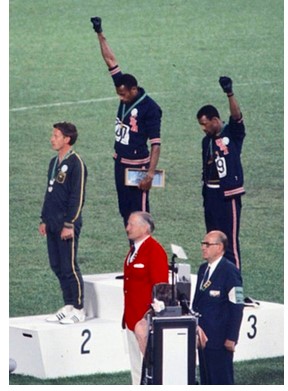
Not every sports organization or league welcomes political activism by athletes. In advance of the 2020 Olympic Games in Tokyo, the International Olympic Committee issued a ban on political protests at Olympic sites. While athletes are allowed to make statements during press conferences, media appearances, and on digital and traditional media platforms, during events or medal ceremonies, they cannot display any political messaging (including signs or armbands), make gestures of a political nature (like kneeling), and refuse to follow the Ceremonies protocol (IOC Athletes’ Commission, 2020).
Nevertheless, American Raven Saunders who won the silver medal in the shot put competition raised her arms over her head to form a X during the medal ceremony in defiance of Olympic rules about protests on podiums. Saunders who is Black and queer said the X represented the location where all oppressed people meet. In addition, before their bronze medal game, all but one of the starters on the U.S. women's soccer team knelt before the kickoff but after the playing of the national anthem to protest racism. The referees knelt as well. Teams from other countries had been kneeling before kickoffs throughout the soccer tournament (Yahoo! News, August 5, 2021).
Saunders' actions recall the famous political protest during the 1968 Mexico City Olympics games by American sprinters Tommie Smith and John Carlos who went barefoot on the podium, bowing their heads during the playing of the national anthem while raising a fist with a black glove (see Olympic Athletes Who Took a Stand by Smithsonian Magazine). For their actions, both runners were stripped of their medals, suspended from the team, and banned from the Olympic Village.
It took 51 years, but Smith and Carlos were inducted into the U.S. Olympic and Paralympic Hall of Fame in 2019. The official induction citation states Smith and Carlos “courageously” stood up for racial equality (Fung, 2019).
In this book, you can learn more about the Olympics in Topic 1.1: UNCOVER and about Political Protests in Topic 4.12.
Would you kneel during the National Anthem?
What other forms of political protest would you engage in to express your beliefs for change?
Suggested Learning Activities
- State Your View: Is sitting or kneeling during the national anthem an effective form of political protest?
- What are the positives and what are the drawbacks of these actions?
- Refusing to Stand for the National Anthem: Top 3 Pros and Cons, ProCon.org
- Taking a Knee: The Rights of Students to Peaceful Protest, ACLU Oregon
- #TakeaKnee: Guidance for Principals on Free Speech at Athletic or Other School Events, Association of Wisconsin School Administrators
- Does sitting or kneeling for the National Anthem materially and substantially interfere with the operations of a school?
- The Tinker v. Des Moines Independent Community School District case established that schools may limit student expression only if it materially and substantially interferes with the operations of the school.
- What are the positives and what are the drawbacks of these actions?
- Compare and Contrast Protest Policies
- What are the policies about political protests for the National Football League, the National Basketball Association & Women's National Basketball Association, Major League Baseball, National Hockey League, NASCAR, National Collegiate Athletic Association, U.S. Soccer Federation, and Major League Soccer?
- How National Anthem Rules Differ Across Sports Leagues, ESPN, May 2018
- Write a draft Protest Policy for your school.
- What are the policies about political protests for the National Football League, the National Basketball Association & Women's National Basketball Association, Major League Baseball, National Hockey League, NASCAR, National Collegiate Athletic Association, U.S. Soccer Federation, and Major League Soccer?
- Analyze a Primary Source: "Lift Every Voice and Sing"
- Listen to gospel and hip hop versions of this poem/song by James Weldon Johnson was performed for the first time on Abraham Lincoln's birthday in 1900.
- Why is this called the "Black National Anthem?"
- How does the song express values of freedom, justice and equality?
- Listen to gospel and hip hop versions of this poem/song by James Weldon Johnson was performed for the first time on Abraham Lincoln's birthday in 1900.
- Design a Protest-Themed Sneaker or T-Shirt
Online Resources for the Flag-Related Court Cases
- Key Supreme Court Cases about the Flag Salute
- Minersville School District v. Gobitis (1940)
- In its first decision on the flag salute, the Court said in an 8 to 1 decision that it is in the interest of national unity to allow school boards to require students to salute the flag.
- Texas v. Johnson (1989)
- Court held 5 to 4 that an individual has a right to burn the flag under the First Amendment free expression clause.
- West Virginia State Board of Education v. Barnette (1943)
- In a landmark case, the Court reversed its earlier opinion and held 6 to 3 that students are protected from having to salute the flag or recite the Pledge of Allegiance through the free exercise clause of the First Amendment. The Court stated "compulsory unification of opinion" is antithetical to First Amendment values.
- In a famous statement, the Court wrote: “If there is any fixed star in our constitutional constellation, it is that no official high or petty, can prescribe what shall be orthodox in politics, nationalism, religion, or other matters of opinion or force citizens to confess by word or act their faith therein.”
- Minersville School District v. Gobitis (1940)
- Standing and Reciting the Pledge
- The Supreme Court on the Pledge from Rethinking Schools.
- 5 Facts about the Pledge of Allegiance from the Pew Research Center (September 4, 2013)
- Flag Statute - Rights of Students and Schools
4. INVESTIGATE: Rights in Conflict: School Prayer
The relationship between church and state and the meaning of the First Amendment's Establishment Clause has long been an unresolved issue in U.S. constitutional law. The founders, and Thomas Jefferson in particular, intended to establish freedom of religion as a core principle of American life and that a wall of separation would exist between religion and government. In 1802, Jefferson wrote: “I contemplate with sovereign reverence that act of the whole American people which declared that their legislature should ‘make no law respecting an establishment of religion, or prohibiting the free exercise thereof,’ thus building a wall of separation between Church & State” (Letters between Thomas Jefferson and the Danbury Baptists).
In education, the Establishment Clause creates separation between activities that people do voluntarily based on private religious beliefs and activities that people fund governments to do on behalf of the public interest, including public schools. Separation means that public schools should not be in a position of adopting policies or conducting activities that could be viewed as supporting or endorsing one form of religious practice over another.
In the landmark case, Engel v. Vitale (1962), the Supreme Court ruled that requiring prayer in public schools at the start of the day was a violation of the First Amendment’s Establishment Clause that prohibits the interconnection of church and state. The state cannot hold prayers in public schools, the Court said, even if participation is not required and the prayer is not tied to a particular religion. Read a summary of the case from PBS American Experience. Justice Hugo Black wrote "that in this country it is no part of the official business of government to compose official prayers for any group of American people to recite as part of a religious program carried out by government" (quoted in Irons, 1999, p. 410).
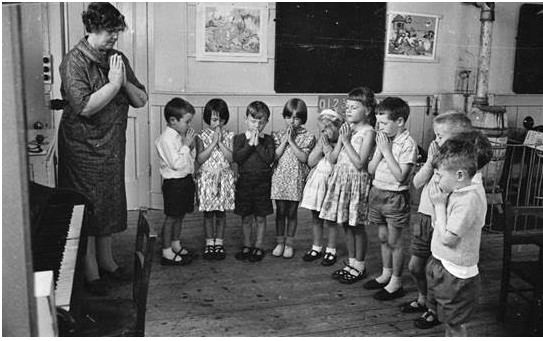
Students Recite Lord’s Prayer in 1963
Source: Laister / Stringer
While debates over school prayer and religion in schools continue today, religion’s place in United States society has changed quite significantly. While 70% of Americans identify as Christian, nearly one in four adults say they are not affiliated with any religion, while another 5% are members of non-Christian faiths (Religious Landscape Study, Pew Research Center, 2020).
Kennedy v. Bremerton School District (2022)
In Kennedy V. Bremerton School District (2022), the Court ruled 6 to 3 that a high school football coach had the right to pray on the school's athletic fields immediately after games. Students, including football team members, had joined him in his prayer gatherings on the 50-yard line. The coach contended that prayer after games was a form of free speech, protected by the Constitution. The school district said the coach was making his personal religious beliefs part of a school event, in effect, putting the school in the position of favoring one form of religious expression.
The Court's majority held that since the games were over, the coach was free to pray on the field, just as other people who attended the event could call a restaurant, post photos on social media, or speak with friends and family. Dissenters said the coach-led prayers placed undue social pressures on students to join or risk being seen as not supporting the coach or his actions.
Suggested Learning Activity
- Research & Present
- Select one of the Supreme Court Cases regarding prayer in education from Religious Liberty: Landmark Supreme Court Cases.
- Research and examine how the Supreme Court decision made a significant change in citizens’ lives.
- Create a presentation, video, or podcast that informs others about the key discussions and decisions regarding the Court case you selected.
- Investigate efforts by states to mandate teaching about Christianity in public school classrooms (e.g, Louisiana requiring every classroom post the Ten Commandments; Texas approved curriculum connecting language arts with biblical studies; Utah designing the Ten Commandments as an historic document).
- Summarize the arguments in the Supreme Court case Kennedy v. Bremerton School District (2022) that upheld a public school football coach's right to hold voluntary prayers at midfield after a game on a school playing field.
Online Resources for School Prayer and Religion Court Cases
- The Establishment Clause and the Wall of Separation, The First Amendment Encyclopedia
- Introduction to the Establishment Clause
- The Establishment Clause and the Schools: A Legal Bulletin, ACLU
- The Two Religion Clauses, from Teaching American History.org reviews the religion debates of the First Congress
5. INVESTIGATE: Rights in Conflict: National Security
The U.S. Naval Station at Guantanamo Bay, Cuba (widely known as “Gitmo”) was established in 1903 after an American invasion of the island during the Spanish-American War. The land for the base was granted to the United States by the Cuban Constitution of 1902.
For most of the 20th century, the naval base served as a coaling station, a ship repair facility, a launching point for supplies during World War II, and a hurricane relief distribution center. Following the September 11, 2001 attacks on the World Trade Center and the Pentagon, the base became a prison for suspected terrorists (Schwab, 2009).
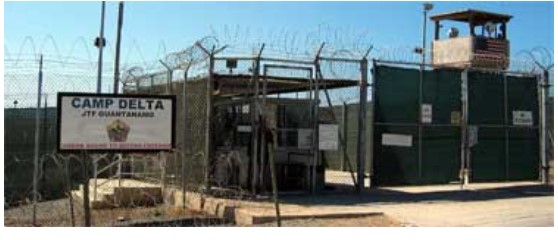
Since 2001, some 780 men from 35 countries have been held at the base. President Barack Obama ordered the detention facilities closed in 2009, although 40 individuals still remain detained at the site (see 40 Current Detainees: The Guantanamo Docket).
In ordering the closure of the prison, President Obama stated that conditions and practices there were “contrary to our values” (Remarks by the President on Plan to Close the Prison at Guantanamo Bay, February 23, 2016, para. 3). Reporters documented exceedingly harsh enhanced interrogation techniques used there, including solitary confinement, physical mistreatment, and other human rights violations. Detainees have not been afforded constitutional rights to fair trials under the military commission system used at the base.
Defenders of practices at the facility cite threats to the nation posed by terrorists, asserting that in times of war or national emergency, some rights and liberties for individuals must be suspended to protect the larger national interests.
Suggested Learning Activity
- State Your View
- Discuss & Debate: Should terrorism suspects have the same civil rights and civil liberties as American citizens?
- Debate Which Civil Liberties Should Be Provided to Those in Prison at Guantanamo, from PBS
- Guantanamo Bay at 10: A Debate about Military Detention, Morningside Center for Teaching Social Responsibility
- Discuss & Debate: Should terrorism suspects have the same civil rights and civil liberties as American citizens?
6. INVESTIGATE: Rights in Conflict: Gun Control
Gun control and rights is one of the most bitterly contested issues in the United States today. Millions of dollars are spent by advocacy groups supporting or opposing limitations of gun sales, background checks, assault weapon bans, and other gun control measures.
Mass Shootings in the United States
The statistics related to guns, gun violence, and mass shootings are stark. Americans own nearly half of all the guns in the world. There are 33,000 gun deaths every year, of which two-thirds are suicides. 85% of suicide victims are males. The remaining gun deaths are homicides (assaults by people and shootings by police officers). In two-thirds of these cases, the victims are young black males. You can explore the data using an Interactive Graphic of Gun Death in America.
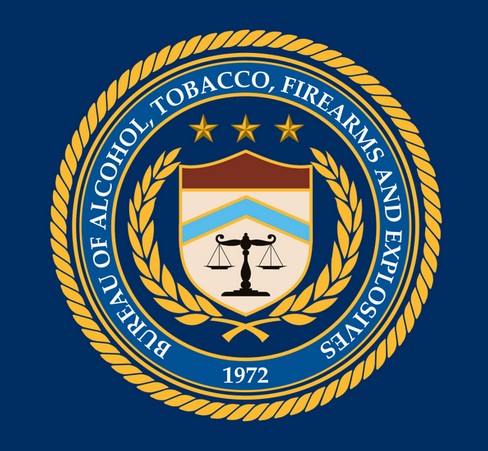
Current Flag of the Bureau of Alcohol, Tobacco, Firearms and Explosives (ATF)
Image on Wikimedia Commons/Public Domain
The United States is experiencing an alarming number of mass shootings. As of 2019, there have been 114 mass shootings in the past four decades and most of the shooters got the guns they used legally (Follman, Aronsen & Pan, 2019a). Of the guns used in these shootings, 48 would have been outlawed if there had been a national ban on assault weapons (Follman, Aronsen & Pan, 2019b).
The National Rifle Association and Changing Viewpoints
People across the country are divided as to how to preserve the rights of gun owners while curbing access to rifles, revolvers, shotguns, semi-automatic handguns, assault rifles, and other weapons of war. The meaning of the Second Amendment to the Constitution is at the center of the debates around guns.
Historian Heather Cox Richardson ("Letters from an American," March 23, 2021) observed that when the Second Amendment was written, the phrase "the right of the people to bear arms" meant being part of an organized militia. The idea that the Second Amendment gives individuals a sweeping right to own guns has emerged from two notable historical developments: 1) the formation in 1871 of the National Rifle Association (NRA), and 2) the emergence at the beginning of the 20th century of rifle shooting as a popular sport. The NRA became a leader in promoting guns as a sporting endeavor.
In the 1970s, however, the NRA moved away from focusing on guns for sport toward aggressively promoting gun rights while stridently opposing gun control legislation. The NRA's political power and budget for lobbying (with huge funding from gun and ammunition manufacturers) grew during the presidency of Ronald Reagan, even though Reagan himself was wounded in an attempted assassination attempt in 1981.
Printz v. United States (1997) and District of Columbia v. Heller (2008)
Since then opposition to gun regulation has become a powerful political talking point for Republican candidates known as Movement Conservatives -- individuals from the wing of the Republican Party that opposes business regulation and government-funded social welfare programs. That viewpoint won a significant Supreme Court victory in Printz v. United States (1997) when the justices (by a 5 to 4 margin) ruled that it was unconstitutional for the federal government to require states to perform background checks for gun purchases.
In 2008, the Supreme Court's decision in District of Columbia v. Heller expanded individuals' rights to own guns at home for private uses.
In 2016, the NRA was the largest outside group contributor to the Trump presidential campaign.
Right-to-Carry Laws
In June 2022, the Court issued a decision in New York State Rifle & Pistol Association, Inc. v. Bruen (2022) that, in striking down a New York State concealed-carry law, effectively said the Constitution allows the right to carry a gun in public.
The New York law, which had stood for 100 years, required an individual to demonstrate a special need for self-protection to carry a handgun in public. However, the Court decided that "New York’s proper-cause requirement violates the Fourteenth Amendment by preventing law-abiding citizens with ordinary self-defense needs from exercising their Second Amendment right to keep and bear arms in public for self-defense" (p. 2).
Gun owner groups and The Federalist Society cheered the decision while the United States Department of Justice took the extraordinary step of disagreeing with the Court's decision.
Suggested Learning Activities
- Evaluate Both Sides
- Review the Second Amendment Court Cases:
- How the Court Has Historically Ruled on Gun Control
- Supreme Court Cases on the Right to Keep and Bear Arms
- District of Columbia v. Heller (2008)
- Court in a 5 to 4 vote upheld the right of individuals to own guns under the Second Amendment, finding the District of Columbia's ban on owning handguns unconstitutional.
- Caetano v. Massachusetts (2016)
- Supreme Court case in which the Court unanimously vacated (overturned) a Massachusetts conviction of a woman who carried a stun gun for self-defense.
- McDonald v. City of Chicago (2010)
- Supreme Court case that found that the right of an individual to "keep and bear arms" is incorporated by the Due Process Clause of the Fourteenth Amendment against the states.
- Discuss & Debate: Does the Second Amendment establish a collective right for armed groups or an individual right for people to possess firearms?
- Second Amendment Speech by a former Green Beret.
- Second Amendment TED Talk by William Harwood
- Review the Second Amendment Court Cases:
Online Resources for Gun Control Laws and Second Amendment Court Cases
- Machine Guns & 50 Caliber, from Giffords Law Center
- Question After Orlando: Are Assault Rifles Banned? No, Only Fully Automatic are Basically Prohibited, Politifact (June 20, 2016)
- 145 CEOs Call on Senate to Pass ‘Common-Sense, Bipartisan’ Gun Laws, NPR (September 12, 2019) (Includes text of the letter sent to the Senate)
- Second Amendment Sanctuary Resolutions
- The Right's Latest Tactic on Gun Laws? Just Don't Enforce Them. Rolling Stone (May 28, 2019)
- Text of Proposed Logan County (Colorado) Second Amendment Sanctuary Resolution (2019)
6.1. ENGAGE: What Steps Should Communities and Governments Take to Reduce Gun Violence?
Assault weapons bans, universal background checks for all gun purchases, red flag laws (or extreme risk protection orders), gun buyback programs, and mandatory waiting periods are among the current proposals for reducing gun violence in the United States. Each has generated strenuous debate between proponents and opponents.
The National Firearms Act of 1934 was the country’s first national gun control legislation. It regulated fully automatic weapons, suppressors, short-barreled rifles and shotguns, and destructive devices such as bombs or grenades. Since 1934, there has been the following legislation:
- Federal Firearms Act of 1938
- Gun Control Act of 1968
- Firearms Owners' Protection Act of 1986
- Brady Handgun Violence Prevention Act of 1993
- Federal Assault Weapons Ban of 1994 (expired 2004)
- Protection of Lawful Commerce in Arms and Child Safety Lock Act (2005)
- National Instant Criminal Background Check System Improvement Amendments Act (2007)
Learn more about these acts from the Federal Acts Regulating Firearms article by the Giffords Law Center.
In June 2022, shortly after the mass shooting of 19 children and two teachers at an elementary school in Ulvade, Texas and during the same week of the Supreme Court's right-to-carry decision, Congress passed, and President Joe Biden signed, "The Bipartisan Safer Communities Act," a gun safety bill requiring background checks for 18 to 21 year olds buying guns. It also provides money to help states enact "red flag" laws that allow authorities with a court order to take guns away from individuals considered dangerous. It includes additional steps to prevent domestic abusers from purchasing guns, addressing the so-called boyfriend loophole. It also included money for increased mental health services.
Other proposals sought by gun control advocates were not part of the bill, including a ban on sales of assault-style rifles to those under 21.
What additional steps would you urge state or federal lawmakers to take to curb gun violence?
Suggested Learning Activity
- Propose Public Policy Action
- What laws and policies should communities and governments enact to reduce gun violence?
- What are current proposals for reducing gun violence in your community?
- State Your View
- In light of recent school shootings, should schools allow greater student access to cellphones so they can use them to contact families during emergencies?
Standard 5.6 Conclusion
Significant Supreme Court decisions known as landmark cases make huge changes in people's lives, expanding their protections and freedoms under the law. INVESTIGATE looked at cases where the Court changed its interpretations of a) First Amendment freedoms; b) the due process and equal protection clauses of the 14th Amendment; and c) cases involving the Pledge of Allegiance, school prayer, national security, and gun control where the rights of individuals may clash with the needs of larger society. UNCOVER reviewed the impact of the Tinker v. Des Moines decision in light of the larger topic of student rights in schools. ENGAGE asked whether students have a right to sit during the Pledge of Allegiance or kneel during the National Anthem and asked what steps communities can take to end gun violence.